Description of the Uralets variety
In the middle of the nineteenth century, the Uralets apple tree was bred. The variety is a hybrid of Voskovka and Anis, it received the best characteristics: it has increased resistance to frost and various diseases, and is unpretentious in care.
- Characteristics of the variety
- Description of fruits
- Description of the tree
- Advantages and disadvantages
- Planting varieties
- Disembarkation dates
- Place for a seedling
- Disembarkation scheme
- General care
- Watering
- Fertilizing culture
- Pruning unnecessary branches
- Breeding varieties
- Preventive work
- Ripening and fruiting period
- Variety variety
- Where to plant the variety
- Gardeners reviews
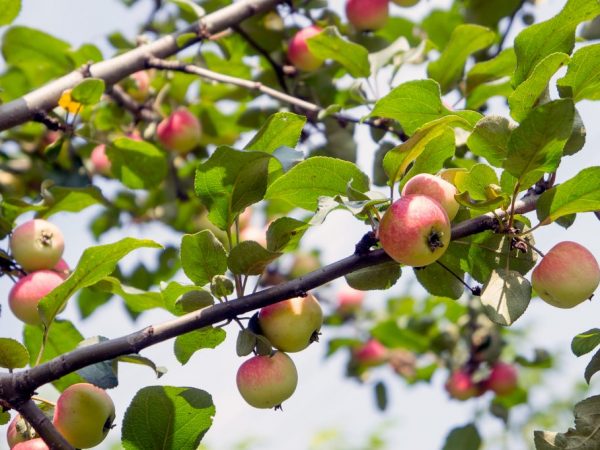
Description of the Uralets variety
Most often, the tree is grown in a temperate climate with a stable temperature regime in summer.
Characteristics of the variety
The Uralets apple variety has the main advantage - increased winter hardiness, but when the ambient temperature drops sharply, it needs proper care.
The tree is resistant to various diseases: it is not afraid of scab or powdery mildew. The younger it is, the more often prevention is carried out - this allows you to enhance the characteristics of the hybrid.
Uralets is distinguished by annual growth. Young shoots in one year can lengthen by 60-70 cm. Even in unfavorable conditions, the growth is at least 30 cm. The level can be affected by pests or diseases that spread on the land.
The apple tree bears fruit every year. In the spring, a large number of ovaries appear and the gardener has to adjust the quantitative indicators of the future harvest.
The yield is high. The fruits are small, but there are many of them on the branches: up to 80 kg can be harvested from one tree.
Record: 120 kg of harvest from one crop. Fruit transportability is good.
Description of fruits
Fruits are formed on shoots that are at least 2 years old.
On young twigs, ovaries can form, but they must be cut off immediately to stimulate the growth of other inflorescences. They are located on the ringlets.
Small fruits weigh 50-60 g each.
What the Uralets apple looks like:
- small fruits weigh 50-60 g each.
- the shape is round, slightly elongated in the center, the surface is smooth, cream-colored;
- a blush in the form of pink stripes appears after ripening, if there is a sufficient amount of sunlight on the land;
- the stalk is medium;
- there is a waxy coating;
The palatability received a high tasting rating. The pronounced "sourness" gives the sweet pulp a piquant taste. The apple has a spicy aroma.
Fruits are used for making compotes or jams. Juices are rarely made.
According to the description, apples are stored for several months and do not lose their marketable appearance. The first fruits appear in the 6th year and the yield gradually increases.
Contains: useful soluble substances, sugar and ascorbic acid. The pulp is rich in catechin - a substance useful to humans.
Description of the tree
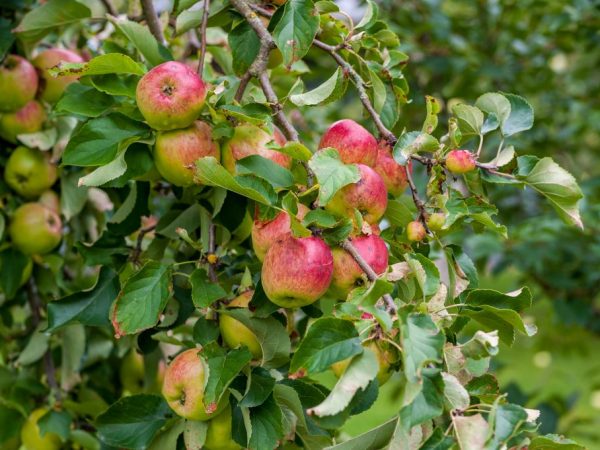
The variety needs good pollinators.
Uralets is a vigorous tree, distinguished by its life expectancy. The crown is massive and strong. If the branches are formed correctly, it has a pyramidal shape. The bark is dark, smooth. Over the years, the upper crust darkens.
- medium-sized matte leaves;
- shortened petiole - round base and small apex;
- there are notches on the leaves - located closer to the edges;
- the buds are pink and the inflorescences are white.
The cultivar needs good pollinators. The Uralian is self-fertile and cannot give a good harvest in isolation.
The best pollinators are varieties of the same ripening period and the same general characteristics (the Ural liquid ones are suitable).
Advantages and disadvantages
The main advantage of the variety is its winter hardiness. The bred hybrid allows for a stable harvest even in regions with harsh winters. The culture resists seasonal diseases well.
The tree has a compact crown, so a lot of free space is not required when planting.
The variety bears fruit early, which is another plus - by the end of summer and by the beginning of autumn, it will be possible to harvest the entire crop.
The disadvantages include the size of the fruit. They are delicious but very small. The crop is poorly stored if the tree was not nourished during the period of fruit formation.
Planting varieties
The Uralets variety, like other apple species, is planted in well-fertilized soil. You cannot buy a seedling and plant it on the same day. Such actions of the gardener will lead to the rapid wilting of the planting material.
Before grafting it, a suitable land plot is selected. To make the apple tree grow faster, it is fertilized and watered abundantly.
Proper care begins half a month before the expected disembarkation date.
Separate requirements for the quality of planting material:
- Saplings must be 2 years old. Annuals will not have time to take root, and their resistance is lower. It is better not to risk and not use a one-year-old before winter - the appearance of the first ovaries depends on the time of planting. Two-year-old planting material is strong, can quickly grow and have time to adapt to the ambient temperature, even in the fall.
- The planting material should be inspected to ensure that there are no points, spots or damage. Under the thin bark, the material should be bright green. The roots show how the scion was grafted. If the root comes off quickly, it means that the seedling was prepared incorrectly - it cannot be planted in open ground.
- A seedling is selected according to two criteria - its roots bend well, and they are moderately moist, and there are no green leaves on the process itself. If the green parts are already on the seedling, it will be difficult to plant it correctly.
Disembarkation dates
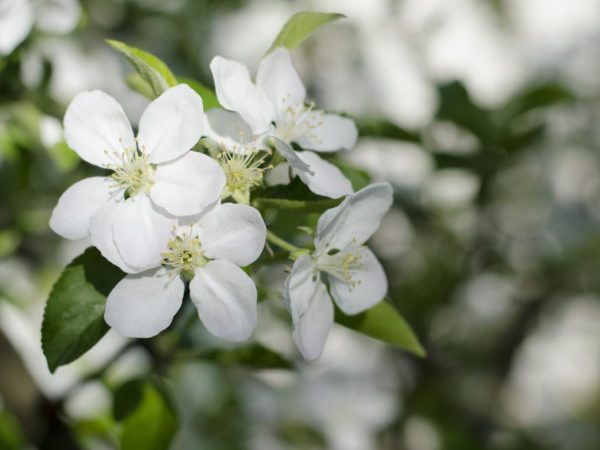
A young tree needs abundant watering
Standard planting is in the fall or spring.
Two-year-old strong shoots are planted in autumn. A suitable period is chosen: you can not plant material if the ground is frozen.
Immediately after planting, the seedling is protected: a shelter is made and additional insulation is created.
If it is planted in spring, the favorable period is calculated according to two factors - the last day of frost and the appearance of the first buds on the branches.
When buds appear on neighboring crops, planting ends.
The shoot will not have time to bloom and the culture will disappear. During spring planting, one should not rush: if the soil is not warmed up, the seedling will not take root.
The optimal distance between crops is 5-6 meters.
Place for a seedling
The Ural is unpretentious to the composition of the soil. It gets along well on clay and sandy soils.
It is important that the seedling does not grow in the lowlands - in such an area, water stagnates and the rhizome begins to rot.
Good lighting is necessary: you cannot plant an apple tree in the shade or under cover.
The distance between the tree and neighboring crops is respected. If the trees have little space, they will create additional shade - as a result, the crop will ripen at different times.
The height of the groundwater should not exceed 3 meters. This is an important condition for the rhizome of the culture to grow properly. The closer the sources are to it, the less nutrients the roots will receive.
Disembarkation scheme
A landing pit is being prepared for the Urals. If a spring planting is planned, the pit is created in the fall.The minimum term for its preparation is 2 weeks. Previously, you cannot plant a seedling.
Pit size: 50 cm in diameter and 50 cm in depth. The depth depends on the size of the rhizome. The larger the seedling, the higher the rate of root growth.
The pit is fertilized immediately. This is an important part of planting: fertilization saturates the soil for two weeks. For fertilization, organic matter is suitable - compost or humus. If slurry is used, then concentrated organic matter is diluted with screened out clean water.
Organic matter is placed in a hole in a thick layer - not less than 5 cm. Fertilizer is left for a week, and after 7 days, the top layer of soil is dug up with top dressing, left for another week.
After two weeks, crushed stone drainage is laid on the bottom if the groundwater is too high.
For soils with moderate moisture, drainage is not necessary.
A stake is placed in the center of the pit - it will become a support for a young tree. After that, the seedling is immersed.
The roots of the seedling are leveled. From above they are covered with fresh soil, carefully rammed.
A soil roll is created around the appendix. It protects the crop and improves root moisture.
Immediately after planting, the seedling is watered abundantly - at least 3 buckets of settled water are required.
General care
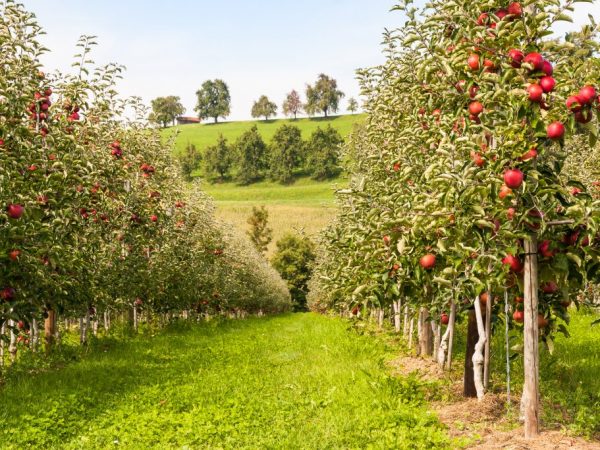
The tree needs to be well looked after
First you need to give the scion time to adapt.
Two weeks later, the young tree begins to independently regulate internal metabolic processes - it needs regular care.
Watering
The root part and the whole culture are irrigated. A suitable method is drip. To improve watering, it is combined with top dressing and soil loosening.
The optimal amount of hydration is 3-4 times per season. This scheme does not change in the summer.
The amount of watering during the rainy season is reduced in order not to harm the root system of the tree.
In the warm season, watering is carried out in the early morning or evening. It is better to avoid the process during the sun.
The root layer is watered. To do this, create holes around the tree - moisture is introduced into them.
If the tree is poured at the base, soil leaching will begin. By such actions, the gardener will harm the rhizome and make the apple tree weak.
For irrigation, tap water or rainwater is suitable. It settles in the sun, during which it is heated to the desired temperature.
River water is not used because it contains a large number of dangerous microorganisms.
Fertilizing culture
For the apple tree, two types of fertilizers are used: mineral and organic.
The first type is complex, commercial mixtures. They combine different substances necessary for proper growth.
Organic fertilizers are natural. These include humus, compost, or chicken droppings. Such mixtures are useful, but they need to be introduced according to the scheme so as not to cause the opposite effect.
An excess of organic matter leads to a weakening of the apple tree.
When and how fertilization is applied:
- Fresh manure. Used in the spring for digging. In autumn and other seasons, it is introduced for the growing season. 10 kg of organic matter is added per 1 m² of land. Balanced composition: 10 liters of liquid composition is diluted with 1 part of the barn.
- Humus. Consists of decayed parts of plant origin. It is applied as an independent agent or used to dilute manure. Used 3 times a year.
- Bird droppings. It contains a large amount of nitrogen, which contributes to the rapid growth of the apple tree. Used until harvest - in spring and summer. A complex solution is created: 100 g of droppings and 15-17 liters of purified water. The solution is infused for at least a week.
- Wood ash. Helps a useful component in strengthening the tree. It is suitable for maintenance work. Ash is used instead of purchased potash fertilizers.
- Bone flour. Also contains nitrogen and calcium. The best times to use bone meal are summer and spring. The product is divorced according to the instructions.
- Nitrogen fertilizer.When the tree grows a lush crown, nitrogen fertilizers are applied. This happens in the spring, and at other times the purchased nitrogenous substances are replaced by organic matter. Stimulates nitrogen and rapid ovary formation.
- Phosphorus additive. Helps to accelerate the growth of rhizomes, but is not used together with nitrogen, because it neutralizes its effect. Used in concentrated mixtures.
Pruning unnecessary branches
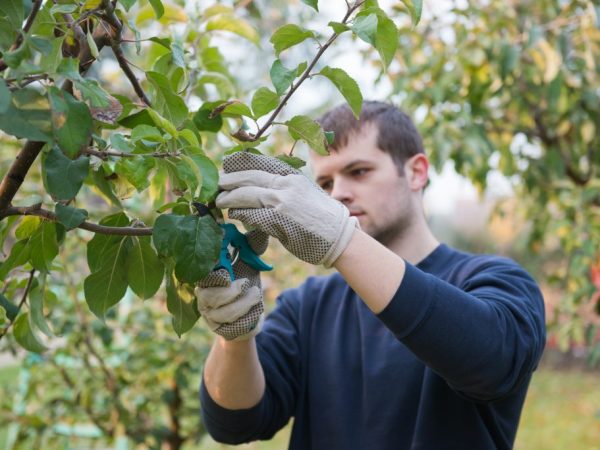
The tree needs pruning
In order for the apple to ripen quickly and correctly, and the tree to endure the winter, branches are annually pruned.
It is better to double the number of procedures - pruning in spring and autumn.
In the spring, the formation of the crown is carried out: branches are cut that grow crookedly or shade other shoots.
Pruning is done before bud formation. You need to wait until it gets warmer so that the cut crop will recover faster.
The second type is carried out in the fall, after harvesting: cut off old, broken or diseased shoots. Such pruning is called sanitary, because it allows the Urals to be prepared for the arrival of winter.
The cut sites are disinfected. During pruning, all branches are examined for the presence of pest eggs.
Crown formation in a neglected tree
For such a tree, sanitary and mandatory pruning is carried out at the same time.
No more than 7 healthy and full-fledged branches are left. The center conductor must be flat and strong. The rest of the branches are completely deleted.
Shoots directed towards the center of the trunk are cut first. After that, diseased or broken processes are removed.
When the crown becomes less dense, the main and side branches are selected, which remain - they should be located at the same distance from each other. The center of the crown should be fully illuminated.
Breeding varieties
Seeds
It turns out a stock or a new hybrid: depending on what pollinators the original culture had.
Layering
Several crops are obtained from one seedling at once.
The seedling needs to be planted at an angle in the autumn, and by the spring it is covered with soil - the planting material "lies".
After that, it is constantly moisturized. It is important to cover and protect well during winter. With the arrival of the new season, he is seated.
Graft
The stock is bought. In this case, a wild or already grafted variety is used. It must have high winter hardiness and not be prone to common diseases.
A good option is the Ranet variety.
Preventive work
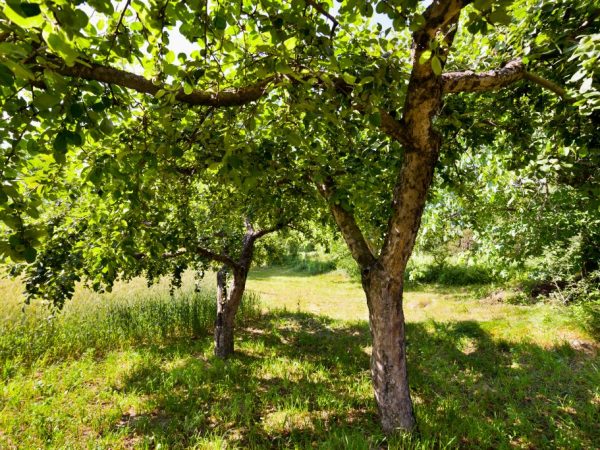
Preventive measures need to be taken to prevent disease.
Pruning in autumn prevents the proliferation of parasites, and proper watering prevents fungal diseases from developing.
After any work, it is better to process the tree.
For the winter, the branches are protected with nets to prevent the attack of rodents. Spraying is carried out once a year if neighboring garden crops are ill. For this, fungicides are used.
Ripening and fruiting period
Under normal conditions, fruiting begins in the 5th year.
If the region is characterized by low temperatures in winter, the first fruits do not appear until the 7th year.
Apples ripen fully by the end of August or by the middle of September: it all depends on the weather conditions. Uralets bears fruit regularly, the average yield is 60 kg per tree.
Apples ripen at the same time, but you cannot leave them on trees for a long period.
By storing fruits in ordinary boxes, which are placed in a cool, semi-dark room. It is better not to collect fruits of different crops in one box. Average shelf life is 2 months.
Variety variety
The Uralets on the trunk is a beautiful apple tree, it has a columnar or pyramidal crown shape.
Ural bulk (also called the crying apple tree) belongs to medium-sized varieties. The average fruit weight is up to 60 g. The color of the apples is yellow, the aroma is pleasant.
Ural's assistant is a vigorous variety. It bears fruit annually in mid-autumn. Has a large pyramidal crown.Differs in high winter hardiness. One apple weighs up to 70 g.
The handsome Uralets is a young variety. Vigorous apple tree with red fruits. Differs in high winter hardiness. The weight of one fruit is up to 130 g. The handsome man is resistant to most diseases.
Where to plant the variety
According to the description, the Moscow region and the surrounding area are the most suitable for growing the Urals.
At temperatures below average, the crop takes root well and gives a stable yield. Suitable for vaccination on the territory of Ukraine.
Gardeners reviews
Most of the reviews about Uralts are positive.
The variety has tasty fruits stored and transported without problems. The rapid growth of the seedling and the unpretentiousness of the tree are noted. The yield increases over the years.
Minimal care at the same time serves as the correct prevention of various diseases.
The tree adorns any garden and takes up little space. Gradually, the variety is grafted and used for planting new planting materials.

